Garden flowers blooming all summer: an overview of the best varieties
The secret of an ever-flowering flower bed lies in planting such varieties of flowers, the flowering of which will follow each other, that is, some will fade and are replaced by others. Therefore, plants that are able to bloom throughout the summer season are simply irreplaceable when creating beautiful compositions. Gardening enthusiasts can select annual varieties and create unique compositions every year. And if it is not possible to devote a lot of time to flower beds, then you can limit yourself to perennial species and annually maintain the beauty of the flower bed, carrying out simple care.
Each plant requires certain care, but there are also certain general rules for creating decorative beds, borders, alpine or flower beds. For these purposes, both low-growing and tall varieties of flowering plants are used.
Content:
- How to care for different varieties of flowers
- How to properly break a flower bed
- Perennial flowering plants
- Varieties of annuals
How to care for different varieties of flowers
The main problem when decorating flower beds with annual varieties of flowering plants is stretching. Long stems can ruin the whole look of the composition, giving it a bare, sloppy look.
The second problem is the rapid development of green mass, which closes the flowers and the flower bed takes on the appearance of a green hillock with rare heads of small flowers.
But if you adhere to some rules, then such problems can be avoided:
- you should not overfeed plants with nitrogen fertilizers, which activate the growth of greenery, but negatively affect the formation of flowers
- you need to feed the plants with fertilizers for flowering plants, in which all the components are balanced in the right doses. Such dressings are widespread in specialized stores.
- no need to thicken the planting. A certain distance must be maintained between the plants so that they are not cramped.
- do not break flower beds in shaded areas, most flowers cannot stand the shade and stretch out, trying to reach the sun
- it is also necessary to carry out regular pruning of foliage and faded flower heads
It is much easier to care for perennial representatives. After planting flowers, it is enough to maintain their beauty by resorting to simple rules. Many representatives of perennial flowers easily overwinter in a permanent place and do not require moving to a warm place. And the flowering of such varieties can last until late autumn, which emphasizes their advantage over annuals. Also, perennials wake up earlier after winter and are able to rapidly transform the flower bed, and the ease of reproduction contributes to the rapid rejuvenation of flower beds.
How to properly break a flower bed
Before planting plants, preparatory measures should be taken, which consist in studying the characteristics of the soil and the illumination of the site, you should also find out the preferences of the selected varieties of flowers and find out whether the conditions are suitable for them.
But the main condition for an ever-flowering flower bed is the selection of species with a certain flowering period, which will complement and replace each other.
Only in this case, you can create a flower garden that will decorate the site from early spring until frost. When making a plan for a flower garden, you need to focus on the size of the flower bed and its placement on the site, and then decide on the location of flowers on it and choose a color scheme that can change periodically.
It is worth showing a little imagination and the garden can be decorated with flower butterflies, star hearts, rivers and even waterfalls. In the complex, such compositions can recreate a fabulous country where a person will relax, enjoying the beauty and aroma.
Perennial flowering plants
All perennial flowering plants are divided into two groups:
- Wintering flowers are winter-hardy flowers that do not need to be transplanted for the winter in the warmth. These include: astilba, primrose, fuchsia, pion, lily of the valley, aster, phlox other.
- Not hibernating, which cannot stand temperature changes and must be dug out of the ground for the winter. Such attention should be paid to: dahlia, gladiolus, montbrecia, gangnam and other sissies.
Also, the variety of perennial flowers varies in height and is represented by three groups: undersized, medium and tall.
Stunted. They, like a multi-colored carpet, cover a flower garden or a flower bed, giving the impression that there is no soil under them at all. Such plants look spectacular as an addition to compositions with high varieties, as well as individual meadows. The most decorative and often used in landscape design types can be distinguished:
- gentian with blue-blue flowers, which are often confused with bindweed
- phlox - are the best fit for decorating a voluminous curly flower bed. The color palette ranges from pure white to deep purple hues, so they will fit into any composition
- Aubrieta growing in small bushes with purple flowers
- Carpathian bell - especially effective when decorating live borders
- aquilegia, which is distinguished by an unusual structure of flowers - the golden core is surrounded by oval petals, behind which are located larger pointed petals. The color gamut is quite extensive
- soapwort - a properly formed bush resembles a lilac ball. Very effective when decorating flower beds in pink tones
- dwarf aster, which blooms until late autumn and pleases the eye with lilac, pink and white shades
Medium-sized. They can reach a height of thirty and eighty centimeters. The group is represented by peonies that begin to bloom in early summer, paniculate phlox, double monard, cornflowers and astilbe. They can be used to form independent flower beds, or they can be combined with tall and undersized varieties.
Tall. Often used not only in combination for a flower bed, but also as an individual decor for decorating a garden or hedge... They look spectacular in small flower beds of different shapes and diameters against the background of lower representatives, which hide the stems and emphasize the inflorescences. Tall plants go through a long growing season and in the first half of summer they increase the green mass, which serves as a background for early flowering flowers, and from the second half of the summer season they delight with lush flowering. This group is represented by:
- stock-rosesthat can grow up to two and a half meters
- decorative sunflowers, bright yellow-brown heads of which effectively complement the picture of a blooming garden
- basilis - tall shrubs covered with many pink flowers that bloom by mid-summer
- rudbeckiathat bloom in the second half of summer in large golden buboes
- veronica long-leaved, which differ not only in high stems, but also in bright azure clusters of inflorescences
- lavender, some species of this plant can grow quite tall, and an intoxicating aroma emanates from the lilac meadows
- helenium hybrid, capable of diluting the plantings with a bright yellow color
Varieties of annuals
Growing annual representatives of flowering plants will require more strength and patience from flower growers. In regions with long winters, you need to initially prepare the seedlings, and with the onset of warm weather, plant them in the garden. In warmer climates, annuals are grown by sowing directly into the soil, but flowering occurs later.
Unlike perennials, such flowers do not require preparation for winter, they bloom for a long time and every year you can bring to life different fantasies, so the garden will look diverse. In the spring, poppies begin to bloom, begonias, cornflowers and allisums. And starting from the middle of summer, and until the very frost, they are replaced by zinnias, calendula and other types.
Such flowers are able to delight the eye with flowering throughout the summer and fill the garden with a delicate aroma.
Well-formed flower beds look beautiful based on the timing of flowering. The flowers replacing each other will help maintain the blooming appearance of the flower garden for six months or more.
Like perennials, annuals also differ in height and can be:
- Dwarf, which include dwarf phloxes, escholtia, undersized marigolds, lobelia and purslane... Such flowers will harmonize well with both annual and perennial varieties that grow much taller. These flowers are an excellent option for creating spectacular alpine slides and decorating paths and flower beds.
- Medium-sized representatives of annuals are represented by snapdragons, nasturtium, dahlias. Also small shrubs are included here. petunias, castor oil plant, in structure resembling a small tree. Curly or creeping specimens complement the group.
- Tall, long-flowering annual plants include delphiniums, showy sunflowers and morning glory vines. Annual stock roses are also often grown.
More information can be found in the video:
To decorate gazebos and fences, it is customary to use weaving annuals, which are able to braid supports and form cozy shaded corners. Despite the fact that annual flowers are classified as unpretentious, they also require attention and care, to which they respond with abundant and long flowering.
It is better to arrange small flower gardens and flower beds from undersized flowers that do not grow more than thirty centimeters. Large-colored flax deserves special attention, sage, gypsophilus, bloodroot, geranium and carnation... They are beautiful as an independent decor, and serve as an excellent complement to higher grades.
By choosing the right compositions of perennial and annual flowering plants, you can create a beautiful fragrant garden that will be full of colors in early spring and will fade away only with the onset of cold weather. Throughout the entire period, you can admire the change of colors and feel different aromas, because the plants blooming all summer have a huge selection of species and varieties, among which you can choose plants for every taste.



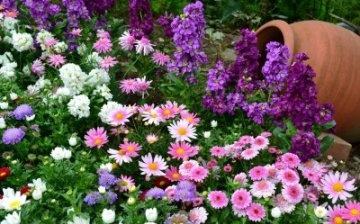
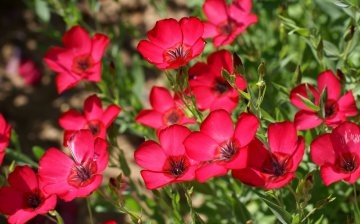
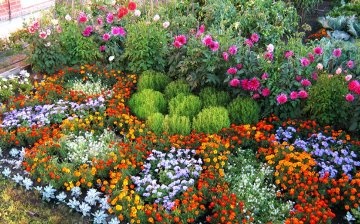
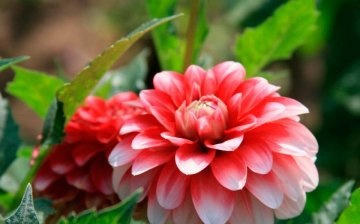

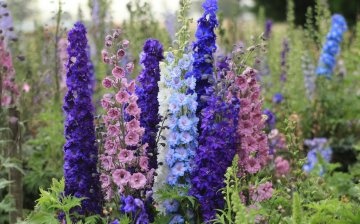






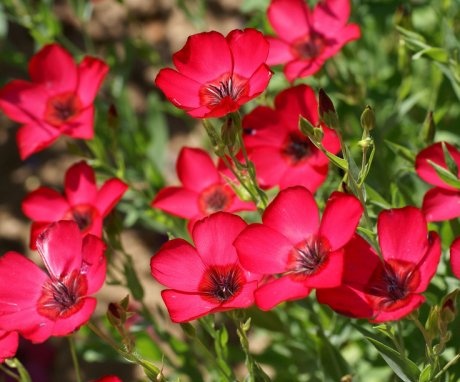


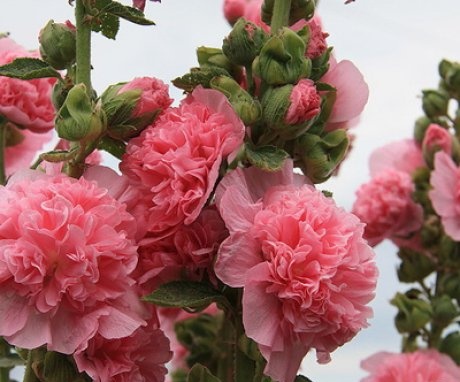
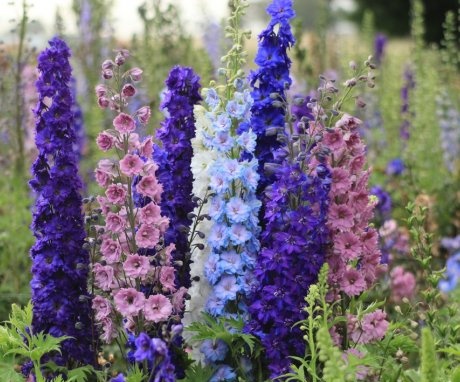
Daffodils, peonies, tulips grow in our flowerbed. We tried to plant a stock-rose, but it didn’t come up. There are also marigolds and several other flowers, the name of which I do not remember. Most of all I like chamomile, we have a lot of these flowers and they bloom for a very long time.